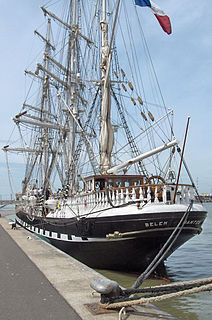This page is based on this
Wikipedia article Text is available under the
CC BY-SA 4.0 license; additional terms may apply.
Images, videos and audio are available under their respective licenses.

The Kent Group are a grouping of six granite islands located in Bass Strait, north-west of the Furneaux Group in Tasmania, Australia. Collectively, the group is comprised within the Kent Group National Park.

A barque, barc, or bark is a type of sailing vessel with three or more masts having the fore- and mainmasts rigged square and only the mizzen rigged fore-and-aft.

Strumble Head is a rocky headland in the community of Pencaer in Pembrokeshire, Wales, within the Pembrokeshire Coast National Park. It marks the southern limit of Cardigan Bay. Three islands lie off the head: Ynys Meicel – 112 feet (34 m) – Ynys Onnen and Carreg Onnen.
While the majority of the clipper ships sailed under British and American flags, more than a hundred clippers were built in the Netherlands. They were medium clippers rather than the larger extreme clipper.

Belem is a three-masted barque from France.
The cluster of rocks that is Barrett Reef is one of the most hazardous reefs in New Zealand.

A windjammer is a collective name for a general class of large sailing ship built to carry bulk cargo for long distances in the nineteenth and early twentieth century. Windjammers were the largest of merchant sailing ships, with three to five tall masts and square sails, giving them a characteristic profile. They usually carried lumber, guano, grain or ore from one continent to another, typically following the prevailing winds and circumnavigating the globe during their voyages. Several survive, variously operating as school ships, museum ships, restaurant ships, and cruise ships.

Booby Island is located 45 km (28 mi) northwest of Muttee Heads at the tip of Cape York Peninsula in Queensland, Australia. This island is in the Torres Strait, 32 km (20 mi) west of Thursday Island and 23 km (14 mi) west of Prince of Wales Island. Booby Island is also known as Ngiangu by the Kuarareg people of the western Torres Strait, its traditional owners, named for the giant Ngiangu who was forced from a neighbouring island It has been called Booby Island by a number of European explorers, including Captain Cook, for the presence of the Booby birds.
Over 1400 ships have been wrecked on the coast of Western Australia. This relatively large number of shipwrecks is due to a number of factors, including:

Gustaf Adolf Mauritz Erikson was a ship-owner from Mariehamn, in the Åland islands. He was famous for the fleet of windjammers he operated to the end of his life, mainly on the grain trade from Australia to Europe.

HMS Alert was a 17-gun wooden screw sloop of the Cruizer class of the Royal Navy, launched in 1856 and broken up in 1894. It was the eleventh ship of the Royal Navy to bear the name, and was noted for her Arctic exploration work; in 1876 it reached a record latitude of 82° North. Alert briefly served with the US Navy, and ended her career with the Canadian Marine Service as a lighthouse tender and buoy ship.
City of York is a local government district in Yorkshire, England.
The Queen Bee was a ship, constructed in Sunderland and launched in 1859. It was used primarily for transporting immigrants from England to New Zealand, having made about 11 journeys before grounding on Farewell Spit in 1877.
William Patterson Shipbuilders was a major shipbuilder in Bristol, England during the 19th century and an innovator in ship construction, producing both the SS Great Western and SS Great Britain, fine lined yachts and a small number of warships.
Lady Kinnaird was a three masted barque which was built in 1877 at Dundee, Scotland by Brown & Simpson for W.B. Ritchie. She operated between the United Kingdom and the Australian colonies. She was lost after running aground in Spencer Gulf south of Cape Burr on the east coast of Eyre Peninsula in South Australia early on 21 January 1880. Her main anchor was recovered from her wreck site in 1979 and was placed on display in the nearby town of Port Neill in January 1880 as part of the commemoration of the centenary of her loss.
Elizabeth Owens was a schooner, built in 1857, at the new San Francisco shipyard of shipbuilder Henry Owens at Steamboat Point where 4th Street met Mission Bay. She was the first ship built in the yard and was named for his wife. Under Captain Albert Bogard, her first voyage was to obtain green turtle and was the first ship to trade at Santa Catalina Island.
At least three British ships have been named Lady Penrhyn for Lady Penrhyn, the wife of Richard Pennant, 1st Baron Penrhyn, of the Penrhyn Estate in Llandygai, North Wales:








